Since the age of bugging adults with an incessant stream of questions, I was preoccupied by figuring out what exactly was “this red stuff” that Yaakov was cooking on that fateful day. Eisav, the outdoors-man, runs in from the fields totally exhausted and demands, “Gimme red, this red!” We learn that his other name, Edom, actually resulted from this demand. The word haadam (red) is repeated twice, and Torah, of course,does not repeat things simply for rhetorical purposes. Was Yaakov cooking several dishes, so his brother was just making sure to clarify the choice? Or is the word itself so significant that even his name is derived from it?
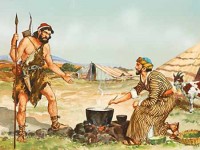
I hear you, preschool and kindergarten Morahs (teachers), how come Eisav is not a redhead in this picture? Don’t we all picture him as a barbarian with a great big head of wild red hair and beard?

Well, it’s definitely great for arts and crafts, and the stark visual contrast will be entrenched in kids’ minds. But – I hate to disappoint you! – the Torah doesn’t say that. It only says that he was born d’moini, which is usually translated as RUDDY, or RED, all over. Red hair? Maybe. Probably. Or maybe not. Is it important? I think not. I think the repetition of the word RED is more important to the understanding of Eisav’s character traits.
So anyway, as we all know, Yaakov says, “No problem, brother, just sell me your birthright, and gei fresn, mamele (literally, go stuff yourself).” Nope, he didn’t say that! What he actually proposed was, “Make your Bechoira (birthright) mine.” And Eisav, who wasn’t really hungry – at least not hungry for food! – but was fatigued after running around hunting all day long, gave an answer that may look flippant, “Hey, bro, I’m gonna die, what good is it to me?” Wait a minute, isn’t everyone going to die eventually? When I was told that my father was terminal, my first reaction was, we are all terminal, we are all going to die, Eisav said it already for all of us, and the timing of it is in H-shem’s hand!
It’s not that simple, though, as Rashi points out. Twins have their own communication code, and Eisav, having heard from his learned brother a description of his duties as a Kohen Godol (The High Priest), as well as the swift punishment by death, should those duties not be fulfilled precisely as H-shem commands, resolves that he is just not up to the task. Yaakov, of course, had known his brother’s character flaws, thus the seemingly outrageous suggestion. The deal is done, Eisav happily sells all his rights and responsibilities, and Yaakov serves him lentil soup (sometimes translated as stew).
This long preliminary is leading to a very simple recipe, lentil soup. Their grandfather, Avrohom Avinu (Our Father Abraham), passed away. Their father, Yitzhok (Isaac), was sitting Shiva (traditional mourning). Yaakov was cooking a lentil soup – or stew – that has since become a traditional mourning meal in Sephardic communities. Conversely, an Eastern European consolation meal would have leikach cake (life is sweet), mashke – a strong liquor (life is bitter), and eggs (the cycle of life and rebirth). Yes, lentils come in a veritable rainbow of colors, from bright green to black, and from yellow to red, but here is the problem: even red lentils, when you cook them, turn brown. Oy vey!
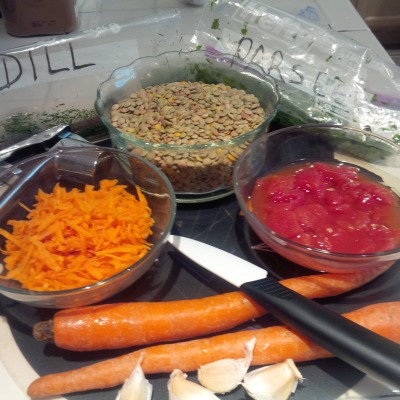
It makes sense to keep using brown lentils, as they are the cheapest. Grated carrots and diced tomatoes add colors, in addition to flavor, but they won’t make it red. Fresh chopped parsley and dill provide a touch of green and contribute to the taste, together with a generous portion of squeezed garlic. There are two ways of making a pareve (meatless and non-dairy) lentil soup, a long one and a short one. The first requires you to sear garlic with carrots on a frying pan first, then throw everything in a pot, add water, bring to boil, season, reduce to simmering and cook. And cook. And cook… The longer, the better!
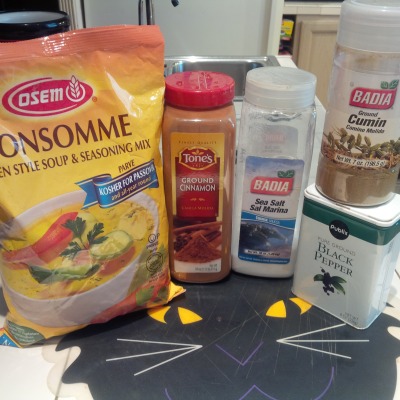
The short way involves using soup powder. I prefer chicken flavor, but there is a variety on the market, so choose your favorite one. In addition to salt and pepper, I season it with cinnamon and cumin. But how do we make it red, after all?
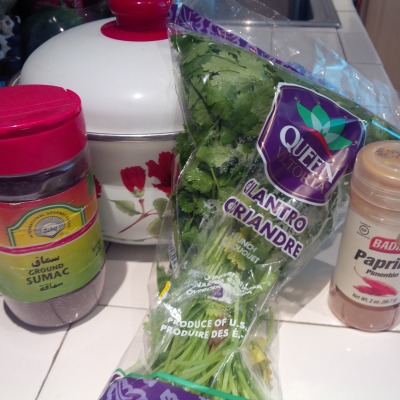
Quite a few chefs, mostly Sephardic, recommend using sumac and paprika. Some also insist on seasoning with cilantro, or coriander, on the grounds of it being the most prevalent herb in ancient Israel, therefore possibly emulating Yaakov’s original recipe. I won’t argue with cilantro – I use it a lot, and love it! – but let me tell you, no matter how much sumac and paprika you dump into your soup, it will stay brown. Look at all the images of it online, and you’ll see what I mean. Sometimes I add some beet juice, if I have it left over from something else, and it contributes a little to the taste, but not to color.
By the way, I am not quite sure that sumac was used in ancient times for cooking, but we do have records of its usage for medicinal and dyeing purposes. The word itself is either Assyrian (that’s Ashur), or Aramaic, and perhaps the red beards sported by Nabuchadnezar, Shalmanazar, Achashveirosh, and the rest of those fashion-conscious kings owed their color to this lemony spice. Did Eisav also use it to get with the style? Just speculating.
And the maskana (conclusion) is, I think the twice repeated RED means something infinitely deeper and more crucial to Eisav’s entire outlook on life than the color of this dish he craves and greedily consumes. This is when he chooses his derech (way of life), and it is hence reflected in his name. This is only my opinion, so don’t quote me, but throw all these ingredients into a pot (a crock pot is even better) and enjoy the simple goodness of this hearty, filling, and very healthy colorful soup.
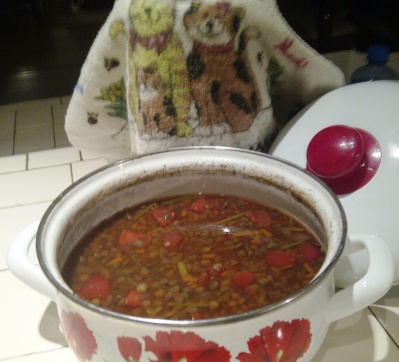
INGREDIENTS
- 1 lb dry lentils
- 2 quarts water
- 1/2 cup grated carrots
- 1/2 cup diced tomatoes
- 2 – 3 garlic cloves, squeezed
- 2 tablespoons fresh chopped parsley, or parsley and dill, or cilantro – your choice
- 1/2 cup beet juice (optional)
- 1 heaping tablespoon of pareve soup powder (your choice of flavor)
- Cinnamon and cumin to taste
- Salt and pepper to taste
- Sprinkle of paprika
- Sprinkle of sumac
PROCEDURE
In a crock pot or stove-top pot, assemble all ingredients, except for soup powder and spices. If using crock pot, put on high for 30 minutes, add soup powder and spices,then turn to low setting for at least 6 hours. If cooking stove-top, bring to boil, add soup powder and spices, then reduce heat to medium and cook for at least 20 minutes, stirring occasionally. As with every bean-based soup, the more you let it cook, the more tender and flavorful it will be.
Enjoy!

Reblogged this on koolkosherkitchen and commented:
This week we are reading the Torah portion about Yaakov (Jacob) and his twin brother Eisav (Esau). I thought it would be appropriate to repeat a recipe which in my house is called “Eisav’s Soup.”
LikeLiked by 1 person
Reblogged this on Top Food and Drinks.
LikeLiked by 2 people
Thank you so much, dear Henrietta, for reblogging! Have a great day!
LikeLike
You are welcome.
LikeLiked by 1 person
I think you have a good basis for your conclusion! Look for a pingback on this!
LikeLiked by 1 person
Thank you so much, Melinda!
LikeLiked by 1 person
You’re welcome, Dolly!
LikeLiked by 1 person
This post was such a blessing to me! My best friend, (sister, really) converted to Judaism a few years before her passing. I loved this story so much because I felt as if she were sharing it with me. Also I gave birth to twin daughters and they do indeed have their own language. I needed to read this morning and I’ll probably read it again. Thank you! (((HUGS)))
LikeLiked by 2 people
Dear Mel, I am so sorry about the loss of your sister! I am glad you like the story, though, and your sister is definitely sharing it with you when you are thinking of her. She is in a better place, but she is also always with you! Hugs and blessings to you and your twins!
LikeLiked by 2 people
Very interesting. I didn’t know that Esau was also called Edom. I’ve recently read through the Torah and your post brought things into perspective. The soup looks great too!
LikeLiked by 2 people
Thank you so much – I am glad you like it! And have you also read that Esau/Edom was the ancestor of Romans?
LikeLiked by 1 person
I hadn’t, but with the name “Edom” (referred to as Edomites in the Torah?) I have begun making those connections. So interesting!
LikeLiked by 2 people
Exactly; Edomites are Romans.
LikeLiked by 2 people
That’s pretty amazing.
LikeLiked by 1 person
Thank you so much! I am glad you like it.
LikeLiked by 1 person
I didn’t know Edomites were Romans- I am not Jewish but the Old Testament refers to them often and hence my question. It is perfectly feasible that Romans were around the Levant in Old Testament times but my question is why does the New Testament refer to Romans as Romans and not Edomites.
People who drink a lot of liquor have a ruddy skin tone which is often smooth, rather than hairy.
A lot of Syrian people of the current generation have red heads and beards and eye brows- so it is possible that Esau was a red head too.
Loved your story. I love another Arabic soup called Shorba- which must be similar to this- it has potatoes added to it.
Do you blend the lentils in this soup ?
Susie
LikeLike
I have been surfing online more than 3 hours today,
yet I never found any interesting article
like yours. It’s pretty worth enough for
me. In my opinion, if all web owners and bloggers made good content as you did, the internet will be much
more useful than ever before.
LikeLike
Can I simply just say what a comfort to find an individual who truly understands
what they are talking about over the internet. You certainly realize how
to bring a problem to light and make it important.
More people must look at this and understand this side of your story.
I was surprised you’re not more popular since you surely have the gift.
LikeLike
There’s definately a lot to know about this issue. I really
like all of the points you’ve made.
LikeLike
Thank you for your comment!
LikeLike
Great post. I’ve had little exposure to the Torah, but I find these little glimpses interesting, especially when they are expertly intertwined with a recipe!
LikeLiked by 2 people
Thank you so much for your kind words and for your interest!
LikeLike
A few of those comments that slipped through, above, Dolly, are spam.
I like making red lentil soup. It comes out yellowy, and delicious. Just make it with whole garlic cloves (so delicious) and garnish with real lemon juice. Easy-peasy — but, no peas.
LikeLiked by 1 person
Lemon juice – aha! Trying it next time I make lentil soup.
As to spam, thank you for letting me know, Rachel! I am trying to catch and kill it, but obviously, some of it slips through my fingers.
LikeLiked by 1 person
Forgot to add that you need to use one whole onion as you cook the lentils.
LikeLiked by 1 person
Will try that as well, thank you!
LikeLike
Reblogged this on Ed;s Site..
LikeLiked by 1 person
Thank you so much for reblogging, dear friend!
LikeLike
Ah, I was looking for a lentil recipe and this popped up very conveniently. Thank you, Dolly.
LikeLiked by 1 person
Serendipity at work! Thank you so much, dear Roberta; I hope you like this soup. Good luck!
LikeLike
” Eisav, having heard from his learned brother a description of his duties as a Kohen Godol”
interesting…
In Turkey this soup is mostly (there are many variations) made using red lentils, tomato paste, every variety of spices (but not cilantro) available in the Aegean, which is where I learned it, first in Istanbul from a Kurdish roommate, and then again in Izmir from Turkish neighbors, and alot of olive oil, and blended.
LikeLiked by 1 person
The Eisav quote is straight Rashi.
I don’t even remember where I saw the Turkish soup, probably at our Greek neigbors’ in Odessa, who were not the best friends of the Turks, but did adopt many recipes.
LikeLiked by 1 person
I know, I’ve seen it before (the Rashi on Esav), but it always gets me…
Yes… My Greek friends still often expect me to call Izmir Smyrna, and Istanbul Constantinople…
LikeLiked by 1 person
So did our Greek neigbors.
I wonder what troubles you about this Rashi?
LikeLiked by 1 person
The anachronism, although I know that Torah was created first, still the idea of a Kohen Gadol before a Beit Midkash, before Yetziat Mitzraim, before Moshe Rabeinu. Does not make sense, despite Rashi being generally quite logical.
LikeLiked by 1 person
I see. It’s a matter of a misnomer. Of course there wasn’t a Kohen Gadol before the Beis haMikdash. However, we do know that both Avraham and Yitzhak knew Kol haTorah Kulam, and we also know that Yaakov not only spent all his time learning with his father, but also learned at the two yeshivos of his time, yeshivos of Shem and Ever. Until Matan Torah, the Bahur – the oldest son – was in charge of observances in the house, as the head of the household. Eisav was not a dummy either, although not a learner, like his brother, so he figured that with this tremendous responsibility comes heavy retribution in case of neglect. By this time he already had three idol-worshipping wives. He was simply afraid of consequences.
Let’s remember that Rashi wasn’t writing in Hebrew or Aramaic, but in old French, and was looking for an equivalent of a Hebrew term which later got translated back from old French to Hebrew.
Does this make sense?
LikeLiked by 1 person
Yes, yes, and ah, yeah! I remember running into some word that was listed as a medieval French word in Mikraot Gadolot, I think, and my chrvrutah and I both baffled!
Yes, oh, I thought the yeshiva of Shem and Ever was one yeshiva. Ok, so learning was more widespread (and no, I hadn’t realized that Esav was in fact learned) than I’d thought. Ok, this makes more sense! Thank you, Dolly! 🙂
LikeLiked by 1 person
Always my pleasure, dear Shira!
Much love,
D
LikeLiked by 1 person
Laila Tov, Dear Dolly!
Safe Air Hugs,
S.
LikeLiked by 1 person
Laila Tov, darling!
Hugs right back to you,
D
LikeLiked by 1 person
Thank you!
LikeLiked by 1 person